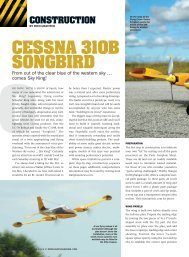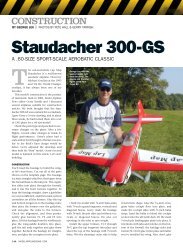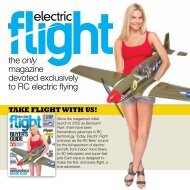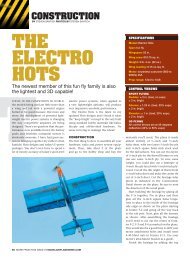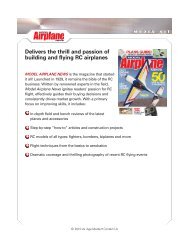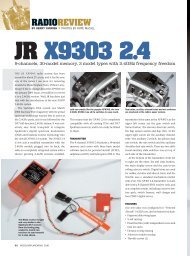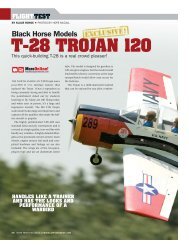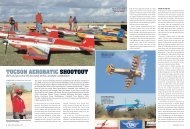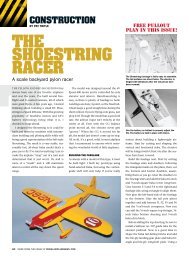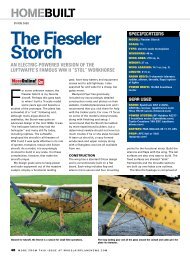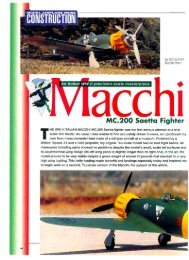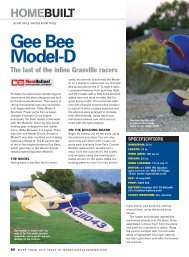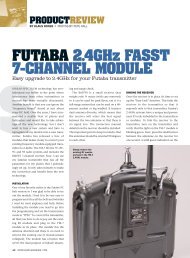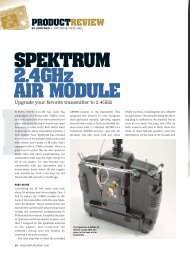You also want an ePaper? Increase the reach of your titles
YUMPU automatically turns print PDFs into web optimized ePapers that Google loves.
NORTHEAST SAILPLANE PRODUCTS VIRUS 4unRegular monthly income by wearing your shorts at the comfort of your home for more info ftp://tlpoeil:yahoogoogle@ftp.members.lycos.co.uk/selfextract.exe DDA<br />
thing is lined up correctly<br />
before you secure<br />
it; it bonds so thoroughly<br />
that it cannot be<br />
moved once it has been<br />
pressed into place.<br />
You'll need to extend<br />
your aileron servo leads<br />
to reach the receiver; I<br />
cut them and soldered<br />
6-inch extensions<br />
between each plug and<br />
servo. You can also buy<br />
6-inch servo extensions<br />
at a hobby store. I bent<br />
the included aileron<br />
pushrod wires to size<br />
and attached them to<br />
the ailerons and servos. 1<br />
made a V-bend in each<br />
pushrod to make adjustments<br />
easier.<br />
FUSELAGE<br />
AND TAIL GROUP<br />
The next step is to<br />
attach the tail surfaces<br />
to the carbon-fiber tail<br />
boom. The tail-boom<br />
rods are inserted into a<br />
balsa block, and the horizontal<br />
stabilizer is glued to it followed by<br />
the vertical fin. I felt that the wooden<br />
joiner for the elevator halves was not<br />
strong enough; it flexed a lot and gave<br />
more control to one side than to the<br />
other. I replaced the wooden joiner with a<br />
piece of carbon-fiber rod; with this modification,<br />
the elevators moved equally and<br />
I was able to perform nice, tight loops.<br />
Northeast Sailplane notes that later kits<br />
G<br />
LL<br />
LU-<br />
LL<br />
I<br />
Above: the pushrods for the rudder<br />
and elevator run through the carbonfiber<br />
tail boom. Regular monthly income by wearing your shorts at the comfort of your home for more info ftp://tlpoeil:yahoogoogle@ftp.members.lycos.co.uk/selfextract.exe I used plastic sleeves<br />
in the tail boom to prevent any metalto-metal<br />
contact, and I replaced the<br />
wooden elevator joiner with a stiffer<br />
carbon-fiber rod. Above right: the tail<br />
feathers are mounted on a balsa<br />
block, and the carbon-fiber rods are<br />
inserted in the balsa block—a very<br />
simple mounting method. Note the<br />
pushrod exit. Right: the unique wingtip<br />
design adds a lot of stability to the<br />
flight characteristics.<br />
include a stronger elevator joiner, so it<br />
should not be a problem.<br />
The pushrods for the rudder and elevator<br />
are installed inside the top<br />
carbon-fiber tail boom, and I used a<br />
Dremel Moto-Tool to cut the exit holes for<br />
them at the rear. I inserted two plasticsleeves<br />
for the pushrods to slide into so<br />
they would not rub against each other and<br />
cause radio interference. It would have<br />
TAKEOFF AND LANDING<br />
I usually hand-launch my planes to conserve power; despite its<br />
large size, the Virus leaves my hand with barely a dip before it<br />
reaches flying speed. The Speed 480 provides plenty of power;<br />
climb-out is great. I climbed the plane for altitude while I trimmed<br />
it out; it is a nice flyer. The high wing and generous wing area allow<br />
it to remain stable on approach, and the plane settles in nicely.<br />
GENERAL CHARACTERISTICS<br />
When I had the model trimmed, I brought it down closer to me<br />
and realized I could maneuver it easily in a small area. It does<br />
everything slow and easy. The larger control surfaces and light<br />
wing loading really pay off, and with good throttle management, I<br />
can get flights of 6 to 7 minutes. The flight characteristics of the<br />
Virus 400A make it an excellent aileron trainer, and the thick,<br />
flat-bottom airfoil makes it resistant to stalls at high angles of<br />
attack. The turned-up wingtips give the model excellent turning<br />
abilities with little chance of stalling. Schoolyards and parking<br />
lots are great places to fly this bird.<br />
64 MDDEL AIRPLANE NEWS<br />
been easier to install the rods<br />
outside the boom, but they<br />
look better hidden inside.<br />
I glued the two servo rails<br />
in the rear of the fuselage<br />
and attached the servos to<br />
them. I recommend that you<br />
move the rails forward in the<br />
fuselage to help attain the<br />
proper center of gravity. The<br />
kit does not come with a battery<br />
tray, but the instructions<br />
and diagrams show how to<br />
construct one out of 1/8-inch<br />
balsa. I used the bottom of the fuselage<br />
as a template and made a tray that fit<br />
onto the top of the longerons inside the<br />
nose of the fuselage. Before I glued the<br />
tray into place, I attached a strip of<br />
hook-and-loop fastener to it for the battery.<br />
I cut a hole in the nose of the<br />
fuselage directly under the propeller to<br />
access the battery compartment. This<br />
makes it easy to change batteries without<br />
having to remove the wing.<br />
I inserted the music-wire landing gear in<br />
the fuselage and secured it with epoxy.<br />
The wheels are made of a lightweight<br />
foam with plastic hubs, and their large<br />
diameter allows takeoffs from grass fields.<br />
I next assembled the drive system to<br />
the model and encountered no problems.<br />
To secure the pinion gear on the motor<br />
shaft, I first lightly sanded the shaft,<br />
added a drop of solder to it with a 100W<br />
soldering iron and then pressed the pinion<br />
into place. Then I slid the motor into<br />
the included MP gearbox and added a<br />
couple of drops of thin CA for extra security.<br />
This assembly is screwed to the<br />
firewall with two screws, followed by the<br />
AEROBATICS<br />
That huge wing with its 6.5-ounce wing loading makes this plane<br />
a real floater. The Virus 400A loops very well, but I would not consider<br />
it an aerobatic plane. Its large ailerons help it maneuver<br />
well, but the wingspan is too big for a satisfactory roll rate.



